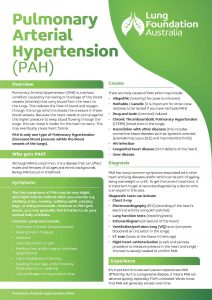The Pulmonary Arterial Hypertension (PAH) fact sheet provides an overview of the causes, symptoms and diagnosis of PAH. The resource provides information to support with symptom management and provides an overview of the treatments available for PAH.
PAH is a serious condition characterized by the narrowing or blockage of the arteries that carry blood from the heart to the lungs. This increases the pressure in these blood vessels, making it harder for the heart to pump blood through the lungs, potentially leading to heart failure.
PAH can affect individuals of all ages, genders, and ethnic backgrounds, though it is uncommon. It can be idiopathic (unknown cause), heritable, drug-induced, or associated with other diseases like connective tissue disorders, HIV, congenital heart disease, or liver disease.
Early symptoms of PAH are often subtle and may include shortness of breath, fatigue, dizziness, chest pain, palpitations, light-headedness, fainting, and swelling in the legs or abdomen. As the disease progresses, these symptoms can worsen, making daily activities more challenging.
Diagnosing PAH involves several tests, including chest X-rays, ECGs, lung function tests, echocardiograms, V/Q scans, CT scans, and right heart catheterization, which is essential for confirming PAH.
Treatment Options
- Medications: Various medicines can help open blood vessels and reduce the work for the heart. These can be taken as tablets, intravenous infusions, or inhaled mists.
- Oxygen Therapy: Used to alleviate shortness of breath
- Transplant Surgery: In severe cases, heart and lung or lung transplants may be considered.
- Rehabilitation: Pulmonary and heart failure rehabilitation programs help manage symptoms and improve quality of life.
Self-Management Strategies
- Lifestyle Changes: Quitting smoking, staying active, eating well, resting, and maintaining a positive attitude.
- Vaccinations: Keeping up with flu and pneumonia vaccines.
- Diet: Reducing salt intake and managing fluid retention.
- Contraception: Discussing safe options with a specialist, as pregnancy can be dangerous for PAH patients.
- Emotional Support: Accessing support for anxiety and depression through healthcare providers or support groups.
Was this page helpful?
Good job! Please give your positive feedback
How could we improve this post? Please Help us.




